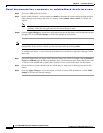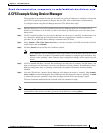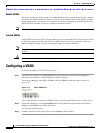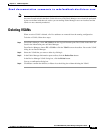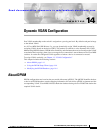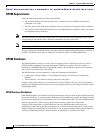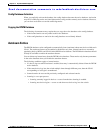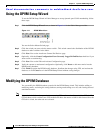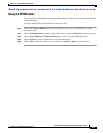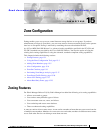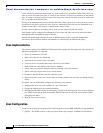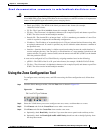
Send documentation comments to mdsfeedback-doc@cisco.com.
14-2
Cisco MDS 9000 Family Fabric Manager Configuration Guide
OL-6965-03, Cisco MDS SAN-OS Release 2.x
Chapter 14 Dynamic VSAN Configuration
About DPVM
DPVM Requirements
Verify the following requirements when using DPVM:
• The interface through which the dynamic device connects to the Cisco MDS switch must be
configured as an F port.
• The static port VSAN of the F port should be valid (not isolated, not suspended, and in existence).
• The dynamic VSAN configured for the device in the DPVM database should be valid (not isolated,
not suspended, and in existence).
Note The DPVM feature overrides any existing static port VSAN membership configuration. If the VSAN
corresponding to the dynamic port is deleted or suspended, the port is shut down.
Note If you copy the DPVM database and fabric distribution is enabled, you must commit the changes.
To begin configuring the DPVM feature, you must explicitly enable DPVM on the required switches in
the fabric. By default, this feature is disabled in all switches in the Cisco MDS 9000 Family.
DPVM Databases
The DPVM database consists of a series of device mapping entries. Each entry consists of a device
pWWN/nWWN assignment along with the dynamic VSAN to be assigned. You can configure a
maximum of 16,000 DPVM entries in the DPVM database. This database is global to the switch and
fabric and is not maintained for each VSAN.
The DPVM feature uses two databases to accept and implement configurations.
• Configuration (config) database—All configuration changes are stored in the configuration
database.
• Active database—The database currently enforced by the fabric.
Changes to the config database are not reflected in the active database until you activate the pending
database. This database structure allows you to create multiple entries, review changes, and then activate
the pending database.
DPVM Database Distribution
If the DPVM database is available on all switches in the fabric, devices can be moved anywhere and offer
the greatest flexibility. To enable database distribution to the neighboring switches, the database should
be consistently administered and distributed across all switches in the fabric. The Cisco MDS SAN-OS
software uses the Cisco Fabric Services (CFS) infrastructure to achieve this requirement.
Using the CFS infrastructure, each DPVM server learns the DPVM database from each of its
neighboring switches during the ISL bring-up process. Conflicts detected during the local and remote
database merge may cause the ISL to be shut down. If you change the database locally, the DPVM server
notifies its neighboring switches, and that database is updated by all switches in the fabric.



